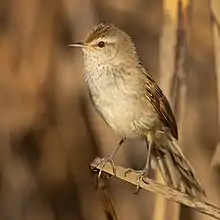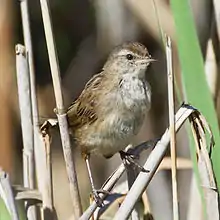Little grassbird
The little grassbird (Poodytes gramineus) is a species of Old World warbler in the family Locustellidae. It is found in Australia and in West Papua, Indonesia. These sexually monomorphic birds are found in reed beds, reeds lignum swaps and salt marshes of South Eastern Australia.
| Little grassbird | |
|---|---|
 | |
| Adult | |
 | |
| Juvenile | |
| Scientific classification | |
| Kingdom: | Animalia |
| Phylum: | Chordata |
| Class: | Aves |
| Order: | Passeriformes |
| Family: | Locustellidae |
| Genus: | Poodytes |
| Species: | P. gramineus |
| Binomial name | |
| Poodytes gramineus Gould, 1845 | |
| Synonyms | |
|
Megalurus gramineus | |
The little grassbird is an inconspicuous and dull coloured bird that is heard more regularly than it is seen, known for readily engaging in conversation with people. They feed on insects and small arthropods, usually remaining densely covered areas of vegetation living nomadically with no regular migration patterns.[2]
Similar Species
The tawny grassbird (M. timoriensis) is slightly larger and less rufous. The striated fieldwren (Calamanthus fulignosus) is quite similar, which is differing due to its yellow underparts, and distinctive white eyebrows.
Taxonomy
Old World warblers are a large group of birds formerly grouped together in the bird family Sylviidae. The family held over 400 species in over 70 genera, and were the source of much taxonomic confusion. Grass warblers are sometimes strongly patterned but generally very drab in overall colouration.[3]
• Genus Megalurus – typical grassbirds (10 species)
Description
13.15cm. Olive-brown/ brown-grey bird with a pale eyebrow with dark grey streaks in the throat, crown and cheeks. The upper body is brown-grey, streaked dark grey and the lighter grey under body is also streaky. The wing feathers dark with white edges. Adult male and female grassbirds are indistinguishable to the naked eye; however, males are larger for all parameters aside from the bill.[4]
Habitat
Little grassbirds live in dense wetland vegetation, reeds, rushes, lignum, tidal marshes, salt lakes and mangroves. They use feathers to line their nests.
Distribution
The little grassbird is found across Eastern Australia and Tasmania, inland to Central Australia and South-Western Australia. It is also found in New Guinea.
Status
The species has been assessed as Least Concern. The population trend appears to be increasing; therefore the species does not reach the thresholds for a vulnerable listing.
Breeding
Breeding period from August to December, or after rain. Nests are deep and cup shaped consisting of grass, twigs and stems lined with feathers typically of the purple swamphen (Porphyrio melanotus) situated in tall grasses, reeds and low shrubs. Clutch consists of 3-5 whitish/pink-white, grey speckled eggs.
Observations of breeding biology and sex allocation have proven a highly male-biased population sex ratio, with some breeding territories having numerous extra males. There is little evidence to determine whether little grassbirds breed cooperatively. Male and female growth showed no notable difference.[5]
References
- BirdLife International (2012). "Megalurus gramineus". IUCN Red List of Threatened Species. 2012. Retrieved 26 November 2013.CS1 maint: ref=harv (link)
- Pizzey, G., Knight, D., Pizzey, S,. (1997). The Field Guide to the Birds of Australia by Graham Pizzey and Frank Knight. 470(3). Retrieved 13 June 2018
- Alström, P.; Ericson, P. G. P.; Olsson, U.; Sundberg, P. (2006). "Phylogeny and classification of the avian superfamily Sylvioidea". Molecular Phylogenetics and Evolution. 38 (2): 381–397. Retrieved 13 June 2018
- McIntosh, R. R., Kats, R., Berg, M., Komdeur, J., & Elgar, M. A. (2003). Breeding ecology and bias in offspring sex ratio in little grassbirds (Megalurus gramineus). Australian Journal of Zoology, 51(5), 505-514. Retrieved 13 June 2018
- Pizzey, G., Knight, D., Pizzey, S,. (1997). The Field Guide to the Birds of Australia by Graham Pizzey and Frank Knight. 470(3). Retrieved 13 June 2018

